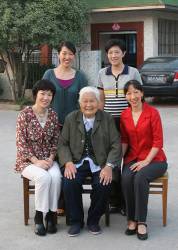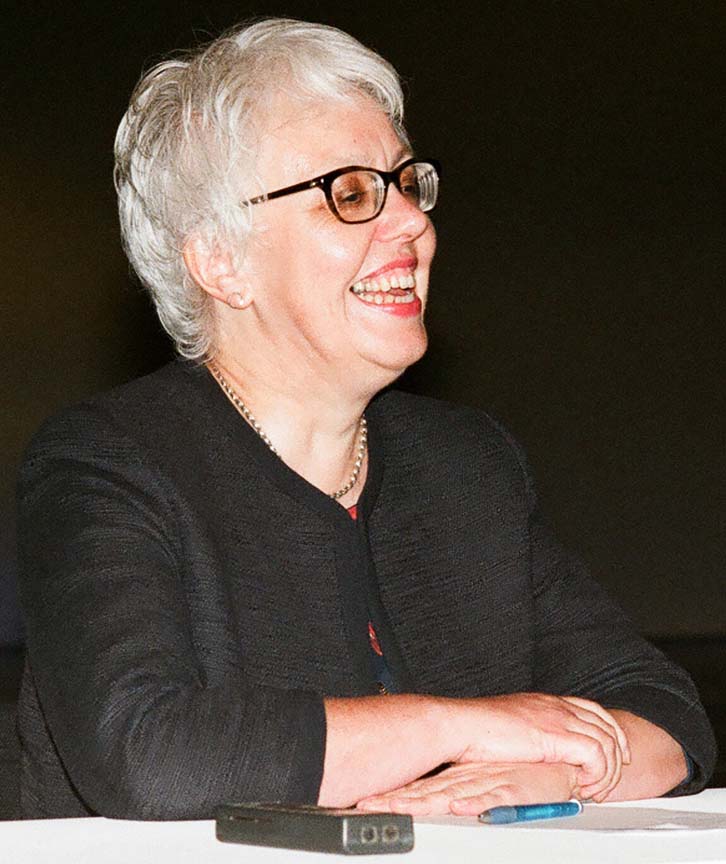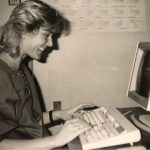 Jade Morton, in the front row at the right, with her sisters and grandmother
Jade Morton, in the front row at the right, with her sisters and grandmother
>>Jade Morton’s Compass Points
Yu — or Jade, in English — Morton is an electrical engineer, a professor at Colorado State University (bound for the University of Colorado Boulder in 2017), and a shining star in the world of GNSS. She left work for eight years to be a full-time mother, then returned to a university professorship and high-level research, where she has been recognized for her work on ionospheric effects on global navigation satellite systems.
>>Jade Morton’s Compass Points
Yu — or Jade, in English — Morton is an electrical engineer, a professor at Colorado State University (bound for the University of Colorado Boulder in 2017), and a shining star in the world of GNSS. She left work for eight years to be a full-time mother, then returned to a university professorship and high-level research, where she has been recognized for her work on ionospheric effects on global navigation satellite systems.
When her father gave nine-year-old Jade an AM radio, she became the only kid in her small Yangzi River delta town to have one, and she listened to its one station from the moment the broadcast started until it went off the air, every day. “That may be when I first became fascinated by radio waves,” she says.
Born to educated parents in Hubei province, she and her three sisters grew up during China’s population boom and political turmoil. Like many children, they were sent to the countryside to live with their grandparents because of their parents’ heavy workload. Her father was a geologist and her mother, a surveyor,who worked for the Chinese Geological Bureau in central China.“They spent a lot of time doing fieldwork, away from home for months at a time,” Morton says. “So, when we were very young, my sisters and I were sent to live with my grandparents in distant Jiangsu Province, on the east coast.”
A Rural Life
The family lived in a small town surrounded by farming communities, about three hours northwest of Shanghai. There was no electricity, no running water, no library, and no TV.
“My sisters and I were very close, and with two aging grandparents, we all had to work very hard,” Morton recalls. Starting at age six, together with her four-year-old sister, they were responsible for the family water supplies and many other household chores.
“I bossed my little sisters around a lot and I was also very protective of them. I think they looked up to me,” she said.
Morton’s parents were able to visit only about once every three years because of the long and difficult journey and the lack of extended vacation time. Morton met her parents only a handful of times before she was grown and left home.
“We did not get to know my parents well,” she remembers. “My grandparents were more like our parents.”
The grandparents encouraged the girls to excel in academics while forbidding them to do anything related to sports and restricting their social interactions, especially with boys, Morton remembers.
“My grandmother was a very hands-on, capable woman. I remember watching her build our kitchen. She was not afraid of trying new things. She cooked every day, sewed all of our clothing, hand-made all of our shoes, and was a great storyteller. She was my role model.”
Morton learned to cook, sew, knit, clean, and take care of her younger sisters at a very young age. But, she says, her grandmother didn’t know much about science and mathematics or engineering.
Voices from a Distance
It was during one of her parents’ rare visits that Morton’s father presented her with the crucial AM radio.
There was only one station, which repeated the same two-hour broadcast three times each day. In addition to an appreciation for radio waves, the radio is how Morton, who then knew only the local Wu dialect (a variation of Shanghainese), learned how to speak the national language, Mandarin.
It was also her father who, from a distance, encouraged her to go into engineering. She communicated with her parents only through letters. They wrote to each other every month, and she remembers a letter from her father around the time she was filling out college applications.
“He had made two lists for me,” she says. One was called “fields you should go into,” and it included topics like electrical engineering, computer science, lasers, infrared, wireless communication, and remote sensing..
The other list was called “fields you should avoid”. Its first item was geology, his own area of work, and the second item was surveying, her mother’s.
“I think my parents regretted being in work that prevented them from taking care of their kids,” Morton says, “and they didn’t want us to ever have to face that.”
Morton followed her father’s advice and didn’t study geology or surveying, but rather physics in which she earned a degree, with distinction, at Nanjing University, and served as a member of the physics faculty. While at Nanjing, she won a scholarship to pursue graduate studies at Case Western Reserve University in Cleveland, Ohio, arriving there in 1985.
It was a big move requiring some big adjustments, but Morton managed. In fact, she got more than she had bargained for: her husband, John Morton. Her roommate at Case was a doctoral student in geology, and through her Jade met John, a geology post-doc at the time.
John’s family approved, Morton believes, because “The first time I met my future in-laws, I won them over immediately by fixing a few appliances that were not working properly.”
Despite the distractions of love, or perhaps because of them, Jade promptly earned her masters degree in electrical engineering in 1987, followed by a doctorate from Pennsylvania State University in 1991.
After she completed her degree at Penn State, her husband took a lab position in the geology department at Miami University, in Oxford, Ohio. Miami was a liberal arts school with no engineering programs. The closest institution Morton could find with programs in her field was the University of Michigan; so, she joined the Michigan Space Physics Research Laboratory as a post doctoral research fellow and commuted four hours between Ann Arbor and Oxford.
By the time her son was born in 1992, the commute had taken its toll. “I ended up quitting my work, moved to Oxford, where my husband worked, and became a full-time mom.” Four years later, her daughter was born.
In 2000, Miami University built an engineering school, and she was hired to start the electrical and computer engineering department. Jade Morton was back in business.
Then Came GNSS
“When I resumed my professional career in 2000, I decided that I wanted to work in an application field that had a direct, visible impact on everyday lives,” she said. She spent two years searching for the ”right” field, and found it.
“The pivotal moment came when I read about work done on software-defined GPS receivers by Dr. James Tsui at Wright Patterson Air Force Base,” she says. “The possibility of replacing hardware functions with mathematics written into software fascinated me,” and that was when she decided to put positioning, navigation and timing (PNT) at the center of her new electrical and computer engineering program at Miami.
Her efforts were encouraged and supported by the administration although she had no prior experience in GPS research. In May 2002, she got her chance to work with Tsui himself at Wright Patterson as part of the U.S Air Force Summer Faculty.
WPAFB was within driving distance of her home and had resources to support a wide range of research projects. Her first project involved mitigation of GPS self-interference for navigation in urban environments.
Morton quickly forged collaborative alliances with outstanding GNSS and PNT researchers at other universities in Ohio, including Ohio University, the Ohio State University, and the Air Force Institute of Technology.
Some of her early projects focused on developing algorithms to improve accuracy and robustness of GNSS receivers and integrated navigation systems. This work ranged from detecting and mitigating multipath, ultrawide band (UWB) interference, and jamming to assessing higher-order ionospheric errors.
It was in the latter field that Morton began to show her particular talents. She went on to develop a unique multi-GNSS data collection system for ionosphere and space weather monitoring. It addressed a problem with GNSS receiver designs employed for that purpose at the time.
“Existing GNSS receivers used to monitor ionosphere and space weather activities are very much based on the same algorithms developed for navigation applications,” Morton says. “They are not optimized for ionospheric effects studies, and measurements generated by these receivers are either inaccurate or not available, especially during strong space weather events.”
In order to get accurate measurements of ionospheric effects on GNSS signals, high quality, raw IF signals need to be collected during the ionospheric events. But, Morton says, it is not feasible to collect data at such a high rate continuously, due to the demand on storage capacities. So, she developed an event-driven, software-defined, multi-GNSS system that records raw IF data only when the events are occurring.
Her solution was built using low-cost, commercial, off-the-shelf, general purpose radios and hardware, with custom-designed control software and post-processing algorithms.
The system has gone through extensive validation and performance evaluations and has been deployed at remote locations for a number of years, including major observatories in Chile, Puerto Rico, Ascension Island, Peru, Hawaii, Singapore, and the United States.
Morton and colleagues have collected nearly 200 terabytes of high-quality GNSS observation data during ionosphere and space weather disturbances, and this year or next they hope to add 13 more stations in Canada, Chile, Hawaii, Puerto Rico, and Ethiopia and are seeking grant approval for three stations at the High Frequency Active Auroral Research Program (HAARP) in Alaska.
In other work, Morton has developed robust GNSS receiver processing algorithms that can “untangle” ionospheric and tropospheric effects from other error sources. And, most recently, Morton has developed new software-defined UWB systems for simultaneous high-resolution imaging, wideband communication, and indoor navigation, much of this work in collaboration with Miami University’s Dmitriy Garmatyuk, an associate professor of electrical and computer engineering.
Morton joins the CU-Boulder Aerospace Engineering Science Department as a full professor beginning in August 20917. Moving to CU-Boulder will allow her more opportunities to collaborate with a larger group of faculty and students with expertise in GNSS and remote sensing and with interests in both engineering and science.
Jade Morton’s star status is confirmed by her awards and appointments, among them the Institute of Navigation (ION) 2014 Thurlow Award and a 2014 fellowship in the Institute of Electrical and Electronics Engineers (IEEE), and service on the editorial boards of a number of technical publications, including some produced by IEEE and ION.
Through it all, Morton remains humble, crediting by name many supporters, partners, and collaborators from throughout her career, way too many to list here. And she seems to have enjoyed every minute of it.
“I have fallen in love with GNSS over and over again,” she said. “The first time I was really thrilled with GNSS was when I worked on an autonomous lawnmower project. We did not have the funds to purchase a differential system; so, instead we bought two low-cost Garmin receivers for $145 and wrote our own differential software. We achieved an average of two centimeters horizontal position accuracy.
“The second time was during an experiment in Alaska. HAARP Scientists had been routinely sending high frequency radio waves into the sky to modify ionosphere plasma distributions. The first time we witnessed the artificially generated disturbance of our GNSS signals was unforgettable”.
Today, Morton says the powerful applications that use GNSS —such as detecting, monitoring, or even forecasting earthquakes, tsunami, nuclear explosions, space and meteorological weather, and global climate — keep her more excited than ever.
Home Matters
Jade Morton also has many years of full-time parenting on her resumé, a clear indication that home life is also a high priority.
“I simply enjoy spending time with my kids, and I enjoy my work,” she says. “If you love what you are doing, then you can find time to enjoy both aspects of life. Work and family do not have to be in conflict all the time.”
Morton says she has always been very close to her kids. She did not travel much when they were young. She packed their lunches, cooked, and they had sit-down dinner every evening.
“We had a very large kitchen with a wide counter space, and when I was cooking dinner, the kids would do their homework on the counter. They loved discussing their school work with me, and not just the math and science problems.”
For the children, the attention seems to have paid off. Her 24-year-old son simultaneously completed four majors — in computer science, electrical engineering, engineering physics, and mathematics and statistics — at Miami University. He is now a doctoral student studying computer science at the University of California, San Diego. He is a National Science Foundation graduate fellow, a Barry Goldwater scholar, and is conducting research in microbial computational genomics.
Her daughter just turned 20 and is a sophomore at the California Institute of Technology in Pasadena, majoring in computer science.
She is proud of them and the time she was able to spend on them. “Thanks to my children,” she says. “I had the opportunity to relive the childhood that I missed.”
Yet she holds no regrets.
“Looking back, I am grateful for having my childhood experiences. They made me stronger. They add rich color to our lives. Personally, I believe that a ‘humble’ background makes one appreciate opportunities more,” she says.
“The harsh conditions of our childhood also helped me and my sisters to build strong work ethics. We learned from a very young age that perseverance leads to significant outcomes. By taking small steps along the way and not giving up, you can achieve what you set out to accomplish even if the task appears so daunting at first.”
Morton and her sisters are the living proof of what she preaches. Two of her sisters now live in the United States. One has a PhD in pharmaceutical science and is working for the Food and Drug Administration in Washington D.C. and the other is a network administrator at the University of Illinois, with master’s degrees in operations research and business. Her third sister, who remained in China, is chief executive officer of her own company.
“Another important lesson we know by heart through my grandmother’s teaching and through our own experiences,” Morton says, “is that trust and respect are not given to you freely. You have to earn them. We do not expect freebees. In fact, we expect to work extra hard to get anywhere. Fortunately, we learned to really like hard work.”
Morton says her children will never go through what she went through, but she has found her own way to steer them in the right direction.
“Despite my career ambition,” she says, “I took off eight years to be a full time mother. I only realized recently that the decision to be home with my children was deeply rooted in my fear of not being able to spend enough time with them.”
We have no fear for Jade Morton. With her children now grown and out of the house, she has time to enjoy cooking, classical music, and the great outdoors, and Colorado is a great place to be.
“My heart sings when I am out in the wilderness,” she says.
And the singing seems to agree with her.





